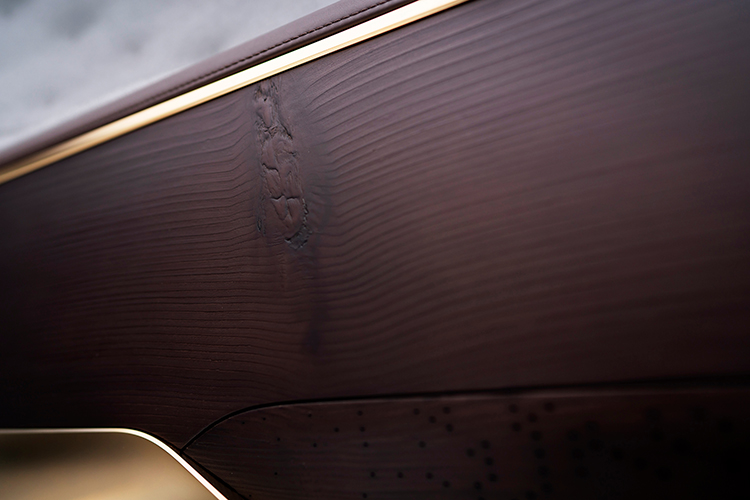HONG KONG – Whether creating ukiyo-e woodblock prints, embroidering a silk obi sash, or even designing the cabin of a new car, Japanese handcraft is subject to two unique approaches to design: 'mitate' (pronounced "mee-ta-teh") and 'shitate' ("shee-ta-teh"). These techniques complement one another, encouraging and enabling craftspeople to imbue their work with an elevated sense of artistry.
'Mitate' relates to the practice of curating and bringing together the best possible selection of materials. This is the process by which artists and artisans carefully consider a range of different materials to work with, selecting those which elevate the character of other materials in use by contrasting or complementing them. In turn, 'shitate' is the execution, well-made, the desire to bring out the very best qualities of the chosen combination of materials. By tailoring, shaping and composing them in certain ways, craftspeople can create something greater than the sum of their parts.
The interplay between these traditional Japanese philosophies inspired INFINITI to adopt a new approach when creating the cabin of the new QX50. The interior of the company's best-selling premium SUV espouses a handmade feel and articulates a sense of human artistry throughout, with a fine attention to detail which extends to the choice of materials and how they are used. The result is a cabin unlike any other in the class – both in terms of its material quality, and its design execution.
The cabin of INFINITI's latest model isn't merely the result of a fleeting inspiration, however. The materials chosen for the production car are the result of a design process that started as early as 2015, when the brand's designers produced the first sketches of what would become the 2016 QX Sport Inspiration concept car. Inspired by the notions of 'mitate' and 'shitate', they experimented with a range of unfamiliar leathers throughout the development of the interior, with the natural characteristics of each material used to dictate the contours of the cabin's surfaces.

Black saddle leather, famed for its robustness, created the structure and shapes of the center console and parts of the dashboard, while softer, passive surfaces were trimmed in white matt and Nubuck leather. The adherence to the 'shitate' philosophy encouraged INFINITI's designers to tailor materials in new and unconventional ways. For instance, the speakers inside the door were housed behind stiff black saddle leather, with 'slashes' in the material creating a bold alternative to more normal speaker covers. The range of materials lent itself to the creation of a dramatic two-tone black-and-white interior, contrasted with tan edging – the natural hue of the leather – where black met white.
In examining how different materials could be used, the design process for QX Sport Inspiration formed the basis for a new way of creating interiors.
Fast-forward to the development of the QX50 production car, and INFINITI's designers – based at the company's design headquarters in Atsugi, Japan – adopted the idea of 'mitate' early in the design process. Instead of drawing on an existing portfolio of tried and tested materials, the car's designers sourced dozens of samples of different wood, leather, metal and thread.
Yet, while the process of selecting each of these materials may be rooted in tradition, INFINITI's designers had one distinctly modern aim as they created a cabin unlike that of any other car on the road: that of authenticity.
The 'shitate' philosophy revolves around understanding the inherent beauty of a material, and this led to a focus on material authenticity – a rejection of an approach adopted by many other car makers.
For decades, wood has been a mainstay of almost every luxury and premium car brought to market. A traditional hallmark of cabin design to provide the perception of quality, the very character of the wood is, nevertheless, often eroded in the production process. Carved, sanded, dyed and glossed, the over-treatment of these materials often creates an over-indulgent, inauthentic appearance – to the point where a knotted, grained sliver of wood loses all character.
The QX50 diverges from this approach. The cabin is trimmed in genuine, matt-finish, open-pore maple, treated in such a way as to retain its natural characteristics – both in terms of its texture and appearance. Running a hand over it, the grain of the wood is still detectable to the touch. The high level of craftsmanship required to achieve this helps to create an authentic, modern and highly tactile dashboard – and one which retains the fundamental character of the wood.

Authenticity also plays a role in the use of genuine leather within the QX50's cabin. The majority of new cars today feature dashboards trimmed in advanced plastics – soft to the touch, certainly, and designed to offer a similar appearance and texture to leather. Some use genuine leather.
INFINITI therefore used a new manufacturing technique to wrap and sew the QX50's leather-bound dashboard, and other surfaces throughout the interior. By adopting this technique, INFINITI's designers have been able to finish the cabin in a carefully-curated selection of supple, indulgent leathers – and to a greater extent than any other premium SUV.
With a one-, two-, or even three-tone color scheme available, different surfaces contrast and complement one another, both in terms of their texture and their appearance. The result is truly authentic, and a step removed from the plastic soft-touch interiors found elsewhere.

Much of the character of the QX50 is reflected in the materials used in its cabin. By curating a range of natural materials – leathers and open-pore woods - and respecting their nature throughout the production process, INFINITI has created a luxurious space quite unlike any other.




